
A Sense of Doubt blog post #2476 - David Bowie on Open Culture
Just a lot of sharing of Bowie stuff today!
https://www.openculture.com/2021/11/8-hours-of-david-bowies-historic-1980-floor-show-complete-uncut-footage.html
Bowie completists rejoice. Eight hours of footage from his 1973 television program “The 1980 Floor Show,” have found their way to YouTube, including, Boing Boing notes, “uncut footage… multiple takes, backstage moments, and all of the dance rehearsals.” The show — actually an episode of the NBC series The Midnight Special curated by Bowie — lived up to its title (itself a pun on “1984,” the opening song of the broadcast), with elaborate dance numbers, major costume changes, and several guest performers: The Troggs, Amanda Lear, Carmen, and — most importantly — Marianne Faithfull, in career free-fall at the time but also in top form for this cabaret-style variety show.
When Midnight Special producer Burt Sugarman approached Bowie about doing the hour-long show, the singer agreed on the condition that he could have complete creative control. He chose to hold rehearsals and performances at London’s Marquee Club, where the Rolling Stones had filmed Rock and Roll Circus in 1968. The audience consisted of 200 young fans drawn from the Bowie fan club. Faithfull was “actually invited as one of the reserve acts,” notes Jack Whatley at Far Out, “ready to be called upon should someone else drop out.”
“The show was heavily advertised in the US press in the run up to the broadcast,” noted Bowie 75 in 2018, “but has never been shown outside the US or officially released,” though bootlegs circulated for years. Shooting took place over three days in late October, just a few months after Bowie played his final show as Ziggy Stardust at the Hammersmith Odeon Theatre, cryptically announcing at the end, “not only is it the last show of the tour, it’s the last show we’ll ever do.” Bowie then went on to release Aladdin Sane and his covers record Pin-Ups the following year, dropping the Ziggy character entirely.*******************************************************
***********************************************************
But Bowie brought Ziggy back, at least in costume, for one last gig in “The 1980 Floor Show,” wearing some of the outfits Kansai Yamamoto designed for the Ziggy Stardust tours and still sporting the signature spiked red mullet he would continue to wear as his dystopian Halloween Jack persona on 1974’s Diamond Dogs. “The 1980 Floor Show” promoted songs from Aladdin Sane and Pin-Ups while visually representing the transition from Bowie’s space alien visitor persona to a different kind of outsider — an alien in exile, just like the character he played a few years later in Nicholas Roeg’s The Man Who Fell to Earth. As Maria Matheos writes at Hasta:
Ziggy no longer played guitar: Bowie had metamorphosed into Aladdin Sane. Parading across the stage in red platform boots and a patent-leather black and white balloon leg jumpsuit, referred to by designer Yamamoto as the ‘Tokyo pop’ jumpsuit, Bowie sought to assault the senses of his audience. Completely over the top? Yes. Verging on a parody of excess? Possibly. Would he have wanted us to take him seriously? He certainly did not (take himself seriously).
With Aladdin Sane, Bowie gave us a hyperbolic extension of his prior alien doppelganger; adding that his character, a pun on ‘A Lad Insane’, represented “Ziggy under the influence of America.”
See how Bowie constructed that new, and short-lived, persona from the materials of his former glam superstar character, and see the revelation that was Marianne Faithfull. The singer performed her 1964 hit, written by The Rolling Stones, “As Tears Go By,” solo. But the highlight of the show, and of her mid-seventies period, was the duet of Sonny & Cher’s “I Got You Babe” with which she and Bowie closed the show. “The costumes of the pair are magical.” Whatley writes,” with Bowie “in full Ziggy attire… aka his ‘Angel of Death’ costume—while Faithfull has on a nun’s habit that was open at the back.”
Bowie reportedly introduced the song with the tossed-off line, “This isn’t anything serious, it’s just a bit of fun. We’ve hardly even rehearsed it.” You can scroll through the 8 hours of footage at the top to see those rehearsals, and so many more previously unavailable Bowie moments caught on film.
via Boing Boing
Related Content:
David Bowie Sings ‘I Got You Babe’ with Marianne Faithfull in His Last Performance As Ziggy Stardust
Bowie’s Bookshelf: A New Essay Collection on The 100 Books That Changed David Bowie’s Life
David Bowie Became Ziggy Stardust 48 Years Ago This Week: Watch Original Footage
David Bowie’s Final Gig as Ziggy Stardust Documented in 1973 Concert Film
David Bowie on Why It’s Crazy to Make Art–and We Do It Anyway (1998)
Josh Jones is a writer and musician based in Durham, NC. Follow him at @jdmagness
When we consider the many identities of David Bowie — Ziggy Stardust, Aladdin Sane, the Thin White Duke — we often neglect to include his transformation into an internet entrepreneur. In line with Bowie’s reputation for being ahead of his time in all endeavors, it happened several tech booms ago, in the late 1990s. Foreseeing the internet’s potential as a cultural and commercial force, he got ahead of it by launching not just his own web site (which some major artists lacked through the end of the century), but his own internet service provider. For $19.95 a month (£10.00 in the UK), BowieNet offered fans access not just to “high-speed” internet but to “David Bowie, his world, his friends, his fans, including live chats, live video feeds, chat rooms and bulletin boards.”
So announced the initial BowieNet press release published in August 1998, which also promised “live in-studio video feeds,” “text, audio and video messages from Bowie,” “Desktop themes including Bowie screensavers, wallpaper and icons,” and best of all, a “davidbowie e-mail address (your name@davidbowie.com).” While the dial-up of the internet connections of the day wasn’t quite equal to the task of reliably streaming video, many of BowieNet’s approximately 100,000 members still fondly remember the community cultivated on its message boards. “This was in effect a music-centric social network,” writes The Gardian‘s Keith Stuart, “several years before the emergence of sector leaders like Friendster and Myspace.”
Unlike on the the vast social networks that would later develop, the man himself was known to drop in. Under the alias “Sailor,” writes Newsweek‘s Zach Schonfeld, “Bowie would sometimes share updates and recommendations or respond to fan queries.” He might endorse an album (Arcade Fire’s debut Funeral earned a rave), express incredulity at rumors (of, say, his playing a concert with Paul McCartney and Michael Jackson to be beamed into outer space), crack jokes, or tell stories (of, say, the time he and John Lennon sat around calling into radio stations together). As Ars Technica’s interview with BowieNet co-founder Ron Roy confirms, Bowie didn’t just lend the enterprise his brand but was “tremendously involved from day one.” As Roy tells it, Bowie kept BowieNet fresh “by exploring new technologies to keep fans engaged and excited. He always preached [that] it’s about the experience, the new.”
It helped that Bowie wasn’t simply looking to capitalize on the rise of the internet. As the 1999 ZDTV interview at the top of the post reveals, he was already hooked on it himself. “The first thing I do is get e-mails out of the way,” he says, describing the average day in his online life. “I’m e-mail crazy. And then I’ll spend probably about an hour, maybe more, going through my site.” Even in the early days of “the controversial mp3 format,” he showed great enthusiasm for putting his music online. He continued doing so even after technology surpassed BowieNet, which discontinued its internet service in 2006. Now, as the coronavirus pandemic keeps much of the world at home, many high-profile artists have taken to the internet to keep the show going. David Bowie fans know that, were he still with us, he’d have been the first to do it — and do it, no doubt, the most interestingly.
Related Content:
Based in Seoul, Colin Marshall writes and broadcasts on cities, language, and culture. His projects include the book The Stateless City: a Walk through 21st-Century Los Angeles and the video series The City in Cinema. Follow him on Twitter at @colinmarshall, on Facebook, or on Instagram.
How David Bowie Used William S. Burroughs’ Cut-Up Method to Write His Unforgettable Lyrics
Why do David Bowie’s songs sounds like no one else’s, right down to the words that turn up in their lyrics? Novelist Rick Moody, who has been privy more than once to details of Bowie’s songwriting process, wrote about it in his column on Bowie’s 2013 album The Next Day: “David Bowie misdirects autobiographical interpretation, often, by laying claim to reportage and fiction as songwriting methodologies, and he cloaks himself, further, in the cut-up.” Anyone acquainted with the work of William S. Burroughs will recognize that term, which refers to the process of literally cutting up existing texts in order to generate new meanings with their rearranged pieces.
You can see how Bowie performed his cut-up composition in the 1970s in the clip above, in which he demonstrates and explains his version of the method. “What I’ve used it for, more than anything else, is igniting anything that might be in my imagination,” he says. “It can often come up with very interesting attitudes to look into. I tried doing it with diaries and things, and I was finding out amazing things about me and what I’d done and where I was going.”
Given what he sees as its ability to shed light on both the future and the past, he describes the cut-up method as “a very Western tarot” — and one that can provide just the right unexpected combination of sentences, phrases, or words to inspire a song.****************************************************************************
As dramatically as Bowie’s self-presentation and musical style would change over the subsequent decades, the cut-up method would only become more fruitful for him. When Moody interviewed Bowie in 1995, Bowie “observed that he worked somewhere near to half the time as a lyricist in the cut-up tradition, and he even had, in those days, a computer program that would eat the words and spit them back in some less referential form.” Bowie describes how he uses that computer program in the 1997 BBC clip above: “I’ll take articles out of newspapers, poems that I’ve written, pieces of other people’s books, and put them all into this little warehouse, this container of information, and then hit the random button and it will randomize everything.”
Amid that randomness, Bowie says, “if you put three or four dissociated ideas together and create awkward relationships with them, the unconscious intelligence that comes from those pairings is really quite startling sometimes, quite provocative.” Sixteen years later, Moody received a startling and provocative set of seemingly dissociated words in response to a long-shot e-mail he sent to Bowie in search of a deeper understanding of The Next Day. It ran as follows, with no further comment from the artist:
Effigies
Indulgences
Anarchist
Violence
Chthonic
Intimidation
Vampyric
Pantheon
Succubus
Hostage
Transference
Identity
Mauer
Interface
Flitting
Isolation
Revenge
Osmosis
Crusade
Tyrant
Domination
Indifference
Miasma
Pressgang
Displaced
Flight
Resettlement
Funereal
Glide
Trace
Balkan
Burial
Reverse
Manipulate
Origin
Text
Traitor
Urban
Comeuppance
Tragic
Nerve
Mystification
“Chthonic is a great word,” Moody writes, “and all art that is chthonic is excellent art.” He adds that “when Bowie says chthonic, it’s obvious he’s not just aspiring to chthonic, the album has death in nearly every song” — a theme that would wax on Bowie’s next and final album, though The Next Day came after an emergency heart surgery ended his live-performance career. “Chthonic has personal heft behind it, as does isolation, which is a word a lot like Isolar, the name of David Bowie’s management enterprise.” Moody scrutinizes each and every one of the words on the list in his column, finding meanings in them that, whatever their involvement in the creation of the album, very much enrich its listening experience. By using techniques like the cut-up method, Bowie ensured that his songs can never truly be interpreted — not that it will keep generation after generation of intrigued listeners from trying.
Related Content:
How to Jumpstart Your Creative Process with William S. Burroughs’ Cut-Up Technique
How David Bowie, Kurt Cobain & Thom Yorke Write Songs With William Burroughs’ Cut-Up Technique
How William S. Burroughs Used the Cut-Up Technique to Shut Down London’s First Espresso Bar (1972)
How Leonard Cohen & David Bowie Faced Death Through Their Art: A Look at Their Final Albums
Based in Seoul, Colin Marshall writes and broadcasts on cities, language, and culture. His projects include the book The Stateless City: a Walk through 21st-Century Los Angeles and the video series The City in Cinema. Follow him on Twitter at @colinmarshall or on Facebook.
CRACKED ACTOR BBC DOCUMENTARY AND OTHER BOWIE STUFF PLAYLIST

https://www.openculture.com/2021/09/david-bowies-lost-album-toy-will-get-an-official-release.html
David Bowie’s Lost Album Toy Will Get an Official Release: Hear the First Track “You’ve Got A Habit Of Leaving”
To the serious Bowie fan, the unreleased self-covers album Toy is not a secret. This collection of reworked pre-“Space Oddity” songs recorded with his touring band from his 2000 Glastonbury appearance was bootlegged a year after it was shelved in 2001. And it has been re-pressed illegally nearly every year since, sometimes as Toy and sometimes as The Lost Album. Some of the fourteen cuts popped up as b-sides over the years, but the whole album? Maybe, fans thought…one day.
Well, that one day is here, as the first single “You’ve Got a Habit of Leaving” dropped yesterday along with an announcement for a larger 90’s-encompassing box set release coming soon after.
According to Chris O’Leary’s Pushing Ahead of the Dame webpage—which you really should bookmark if you haven’t yet—the original version of “You’ve Got a Habit of Leaving” was written when he was only 18, and earned him a reprimand from none other than The Who’s Pete Townshend. ”You’re trying to write like me!” said Pete.
You can totally hear the Who influence in the chorus of the version released by Davy Jones and the Lower Third, which apes the fuzz-guitar freak-outs from “My Generation.”
Three and a half decades and multiple Bowie-incarnations later, and the former Davy Jones decided to look back at those hungry early years and redo some of his songs.
The plan in 2000 was to gather his band and record an album old-school, live, in studio, with all the energy and sometimes sloppiness that used to happen in the 1960s, when most bands got at most two days to record their first albums. The first Beatles album was recorded this way, and look where that got them.
But this also afforded Bowie a chance to fix the weaknesses of those original songs in structure and arrangement. Says O’Leary: “The new version is longer, far more elaborately produced, far more professionally played and it still sounds like a Who knock-off, only a knock-off of The Who ca. 1999. That said, Bowie sings it well and it does finally rock out at the end.”
Bowie’s plan was to quickly finish Toy and drop it unannounced as a surprise to his fans. This is commonplace now—Beyonce and Radiohead have done similar secret releases—but EMI freaked out, balked, and their reaction ultimately led Bowie to leave the label.
Other songs reimagined on Toy include “Liza Jane,” Bowie’s debut single from 1964; “Silly Boy Blue” from his first self-titled 1967 LP; and “The London Boys” a 1966 B-side. The album also includes songs that didn’t make it on the bootlegs: “Karma Man,” the original of which turned up on Bowie at the Beeb from a 1968 session, and “Can’t Help Thinking About Me,” originally released in 1966.
The release will be part of Brilliant Adventure (1992-2001) an 11-CD or 18-LP box set that will focus on Bowie’s third decade. Toy will be released separately as a 3-CD release called Toy:Box, containing “alternate mixes and outtakes.” Better save your pennies!
Related Content:
When David Bowie Launched His Own Internet Service Provider: The Rise and Fall of BowieNet (1998)
How David Bowie Used William S. Burroughs’ Cut-Up Method to Write His Unforgettable Lyrics
Ted Mills is a freelance writer on the arts who currently hosts the Notes from the Shed podcast and is the producer of KCRW’s Curious Coast. You can also follow him on Twitter at @tedmills, and/or watch his films here.

https://www.openculture.com/2016/01/watch-david-bowie-annie-lennox-in-rehearsal-singing-under-pressure-with-queen-1992.html
Watch David Bowie & Annie Lennox in Rehearsal, Singing “Under Pressure,” with Queen (1992)
***************************************************************************
It’s common to feel like we know our artists, writers, musicians, actors… we want so badly to touch their lives in some way, as their lives touch ours. This overwhelming desire is responsible for a huge market share of our mass media, from the most tasteless tabloid hit jobs to the most respectful longform essays. Since David Bowie’s passing, we’ve seen no shortage of the latter, and thankfully little of the former.
Vulture has collected some of the best of these online tribute articles and obituaries, and one in particular—Judy Berman’s “We Always Knew Who David Bowie Really Was“—has resonated with me. Berman cuts through “all the clichés about how he was a chameleon or a shape-shifter or opaque or unknowable” and shows some of the ways Bowie made himself intimately available in his work.
Bowie’s self-revelation by way of theatrics and costume changes resembles the less intellectual, more emotional, vulnerability of his friend and collaborator Freddie Mercury. Just as musicians around the world celebrate, and mourn, Bowie now, he performed a similar service for Mercury 24 years ago at London’s Wembley Stadium for an audience of 72,000 people, along with the remaining members of Queen and a full roster of superstars. Bowie did four songs in total, but the most poignant was certainly “Under Pressure,” which he’d composed with Mercury 11 years earlier. The song became, of course, a massive hit (twice over, thanks to Vanilla Ice’s appropriation). It’s wrenching lyrics also gave us yet more insight into Bowie’s personality: his fears, his sense, as Berman writes, “of how fleeting and insignificant one human life is in the grand scheme of the universe,” and his defiance in the face of that knowledge.
In the video at the top of the post, you can see Bowie, Annie Lennox, John Deacon, Roger Taylor, and Brian May rehearsing “Under Pressure” for the Mercury tribute, with an audience of just themselves and a few crew people. Bowie has one of his regrettably ubiquitous cigarettes in hand and an enormous grin on his face as he watches Lennox belt out Mercury’s parts. The performance on show day, above, is powerful and pitch perfect, but the loose, informal rehearsal footage is more of a treat for those of us eager for as much of the unguarded Bowie as we can get. For even more stripped-down, behind-the-scenes Bowie, listen to an a cappella version of “Under Pressure” with Mercury, and learn all about how that song came to be.
Related Content:
The Making of Queen and David Bowie’s 1981 Hit “Under Pressure”: Demos, Studio Sessions & More
David Bowie and Cher Sing Duet of “Young Americans” and Other Songs on 1975 Variety Show
Josh Jones is a writer and musician based in Durham, NC. Follow him at @jdmagness

https://www.openculture.com/2015/05/96-drawings-of-david-bowie-by-the-worlds-best-comic-artists-michel-gondry-kate-beaton-more.html
96 Drawings of David Bowie by the “World’s Best Comic Artists”: Michel Gondry, Kate Beaton & More
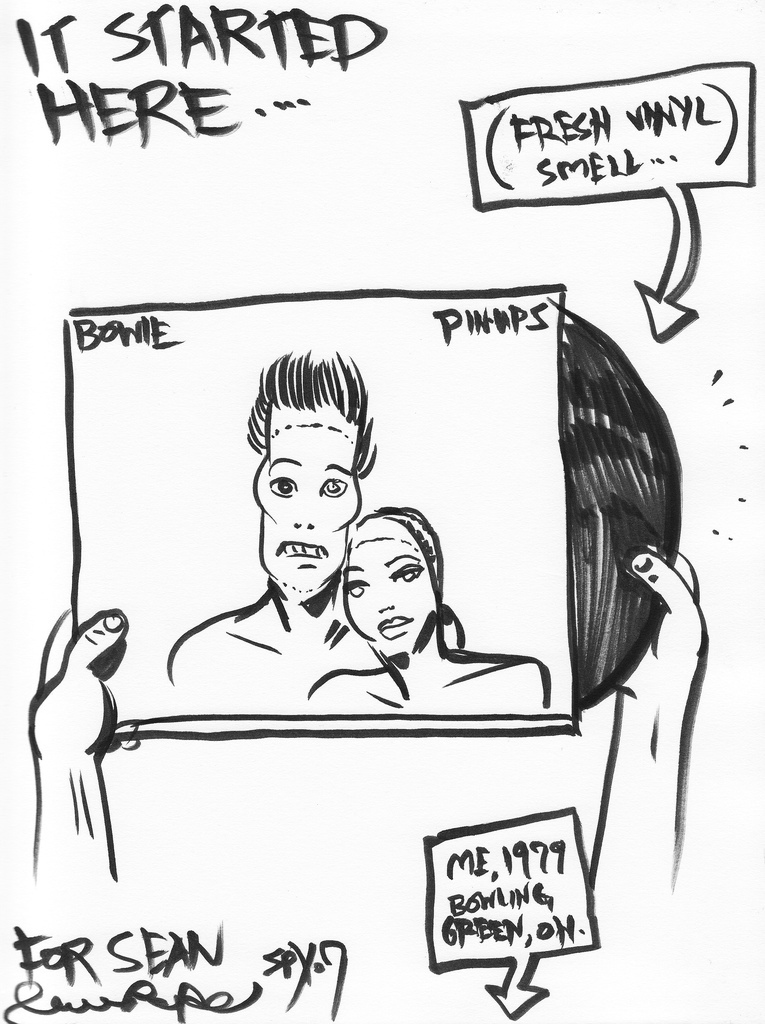
There is a David Bowie for every season. A Christmas David Bowie, a Halloween David Bowie, even a David Bowie Easter celebration. But much more than that, there may be a David Bowie for every Bowie fan, especially for artists influenced by his chameleonic career. See for yourself how a whopping 96 Bowie-loving artists—in this case mainly what Bowie himself calls the “World’s Best Comic Artists”—see the changling rock star/actor/space alien.

“See my life in a comic… The little details in colour,” writes Bowie on his site of a web gallery of portraits compiled by “comic artist, writer and critic, not to mention huge Bowie fan, Sean T. Collins.” It’s called The Thin White Sketchbook—a clever title that alludes to just one of the myriad Bowie personae represented in the sizeable collection of 96 drawings (see a nostalgic one by prolific illustrator Paul Pope at the top—the book’s first sketch).
Collins’ impressive collection includes work from Michel Gondry (Eternal Sunshine of the Spotless Mind), whose contribution the editor calls “pretty goddamn wonderful if you ask me.” See it above. And below, Kate Beaton, creator of web comic Hark, A Vagrant, gives us Bowie as a dandy, a character with whom, writes Collins, she has a “rich history.”
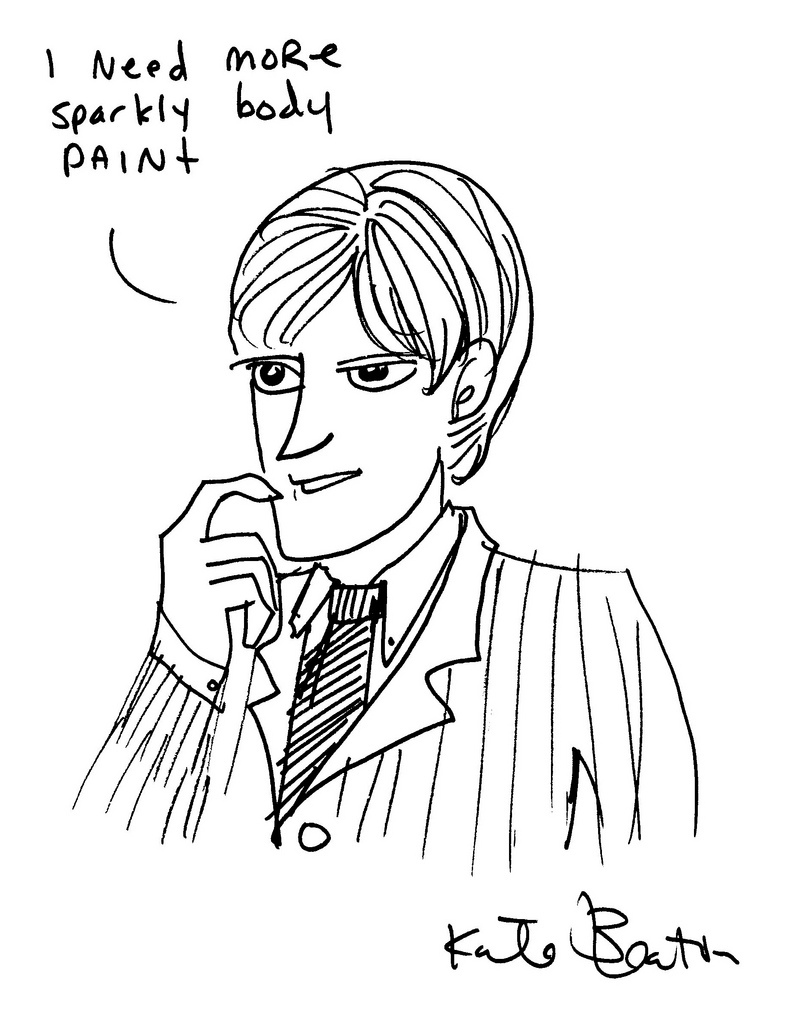
Collins offers brief commentary beneath each image in the collection, which also gives us the strange interpretation below by Bowie-inspired underground comics legend Charles Burns; the intense and Archie-esque contributions further down by Brothers Jaime and Gilbert Hernandez, creators of the 80s New Wave classic comic Love and Rockets; and the outer space-proportioned Bowie at the bottom of the post, from vocalist Tunde Adebimpe of TV on the Radio, a band that has both covered and recorded with Bowie.
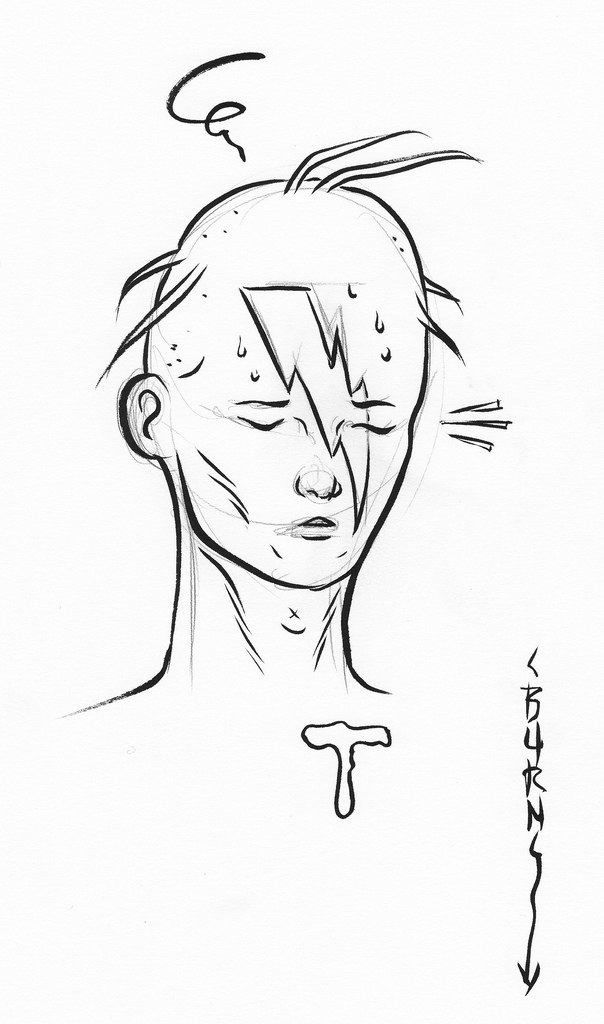
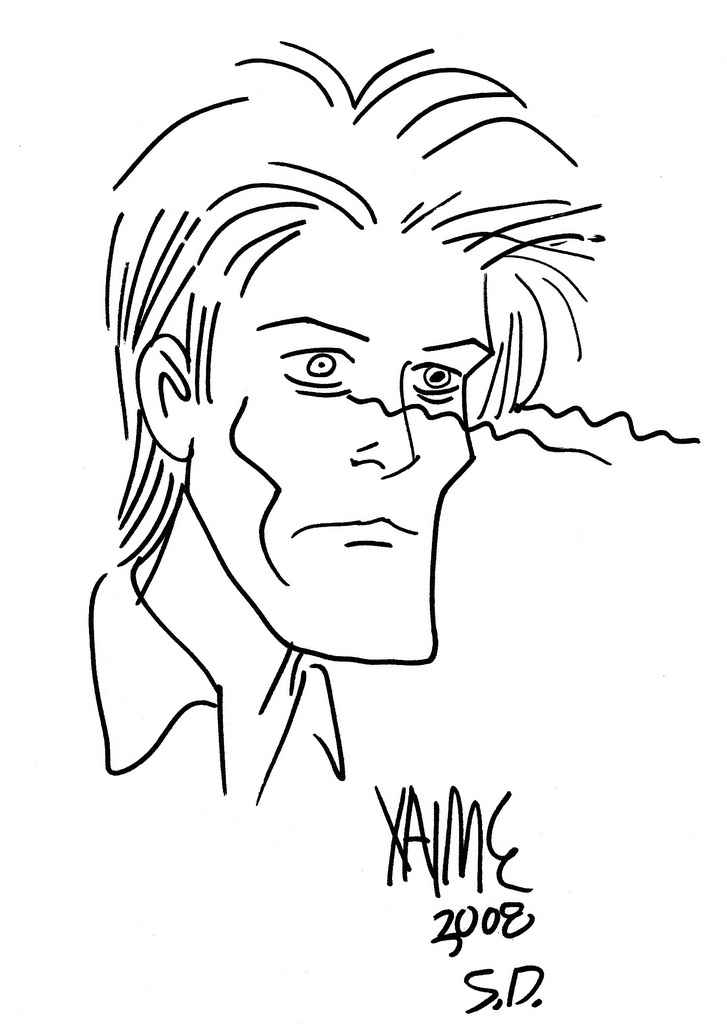
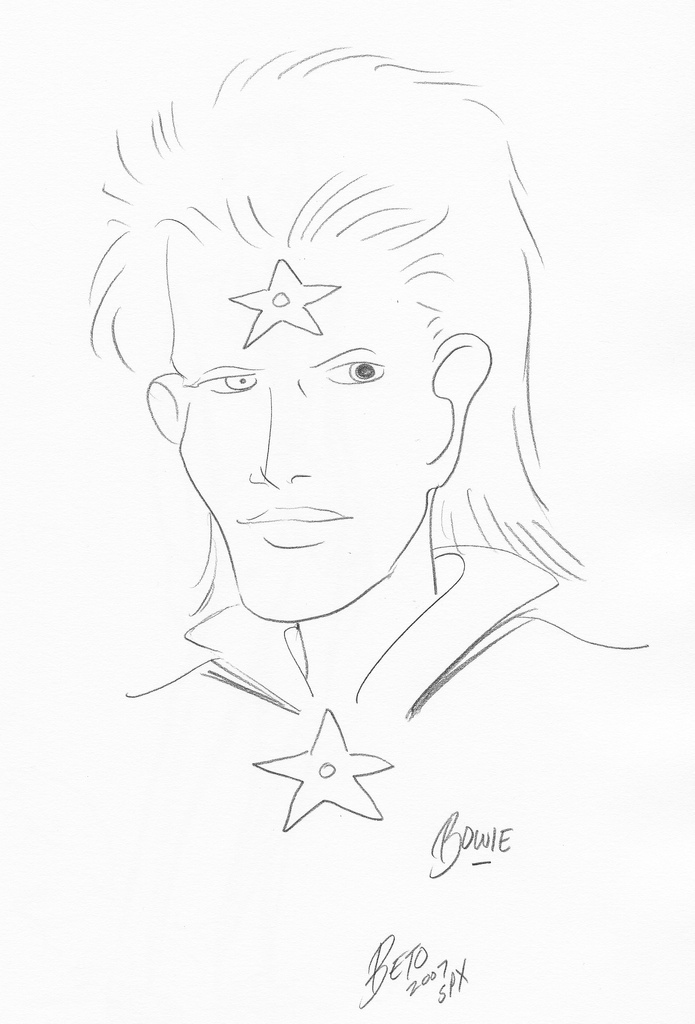

View the full set of Bowie drawings, no two remotely the same, at The Thin White Sketchbook’s Flickr page.
via Buzzfeed.
Related Content:
50 Years of Changing David Bowie Hair Styles in One Animated GIF
David Bowie Releases Vintage Videos of His Greatest Hits from the 1970s and 1980s
David Gilmour & David Bowie Sing “Comfortably Numb” Live (2006)
Josh Jones is a writer and musician based in Durham, NC. Follow him at @jdmagness
SEARCH MORE:
+++++++++++++++++++++++++++++++++++++++++++++++++++++++++++++++++++++++
+++++++++++++++++++++++++++++++++++++++++++++++++++++++++++++++++++++++
+++++++++++++++++++++++++++++++++++++++++++++++++++++++++++++++++++++++
- Bloggery committed by chris tower - 2111.28 - 10:10
- Days ago = 2348 days ago
- New note - On 1807.06, I ceased daily transmission of my Hey Mom feature after three years of daily conversations. I plan to continue Hey Mom posts at least twice per week but will continue to post the days since ("Days Ago") count on my blog each day. The blog entry numbering in the title has changed to reflect total Sense of Doubt posts since I began the blog on 0705.04, which include Hey Mom posts, Daily Bowie posts, and Sense of Doubt posts. Hey Mom posts will still be numbered sequentially. New Hey Mom posts will use the same format as all the other Hey Mom posts; all other posts will feature this format seen here.


No comments:
Post a Comment